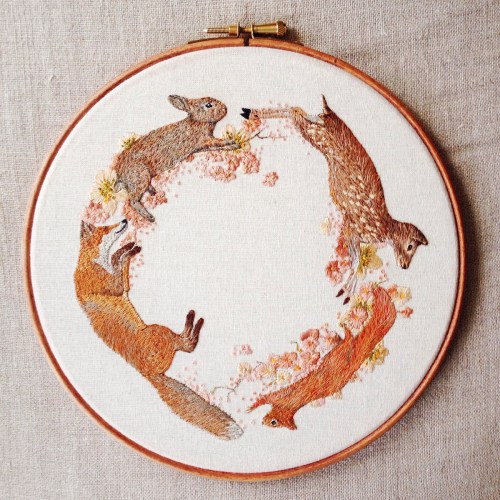Lanas-own-blog - My Personal Space.

More Posts from Lanas-own-blog and Others


Islamic Art
Most everyone is familiar with geometry and patterns. The above image by Richard Henry is included here to give some mathematical frame of reference. The artistic emphasis of these ideas gained prominence due to certain religious rules in Islamic religious texts forbidding the portrayal of human forms in worship. Additionally, the advanced mathematical discoveries in the middle east brought about some wonder toward the patterns of these ideas. The underlying message in such geometries, within the Islamic context, is the infinite and natural power of God. It is important to note that ideas like zero, our decimal counting system, and algebra originated from India and the middle east. Arabic calligraphy is also similarly celebrated and made the subject of many past and current Islamic art.













Pickering’s Triangle










Delicate Nature and Animal Embroidery by Emillie Ferris
UK artist Emillie Ferris composes stunning embroidery illustrations of wildlife and nature into pendants and oval frames. Depicting delicate animals, such as butterflies, deers and rabbits, Ferris’ choice of wildlife subjects exist in the realms of an ethereal forest.
Her embroidery technique displays meticulous talent and detail to color, shape, as well as the texture of fur, which stands out against a clean off-white background. You can find more of her dainty designs at her Etsy shop!







An Adaptable Species: Part 2 of 4 (Part 1) Episode 11: The Immortals, Cosmos: A SpaceTime Odyssey

More Than You Ever Wanted to Know About Mechanical Engineering: Strain Energy for Some Common Situations
Last time, we talked about strain energy - the energy that is stored when an object undergoes deformation due to applied stress. We worked out a general expression for strain energy density (the amount of strain energy stored per unit volume):

Note that this is easily convertible to overall strain energy - we would just have to integrate strain energy density over the volume of the object to get total strain energy.

The dV here is just the product of dx, dy, and dz (like regular volume is the product of x, y, and z). Or, you could say it’s the product of the cross-sectional area (dA) and dx.

Bearing this in mind, we can easily get some simple expressions for strain energy in some familiar situations.
Keep reading
-
 rranaai liked this · 1 week ago
rranaai liked this · 1 week ago -
 cat-mermaid reblogged this · 1 week ago
cat-mermaid reblogged this · 1 week ago -
 cat-mermaid liked this · 2 weeks ago
cat-mermaid liked this · 2 weeks ago -
 itspreciousb liked this · 2 weeks ago
itspreciousb liked this · 2 weeks ago -
 opocalient reblogged this · 2 weeks ago
opocalient reblogged this · 2 weeks ago -
 holyhiei liked this · 2 weeks ago
holyhiei liked this · 2 weeks ago -
 theyadoremonee reblogged this · 2 weeks ago
theyadoremonee reblogged this · 2 weeks ago -
 theyadoremonee liked this · 2 weeks ago
theyadoremonee liked this · 2 weeks ago -
 louielakai liked this · 2 weeks ago
louielakai liked this · 2 weeks ago -
 11theycallmesunshine11 liked this · 2 weeks ago
11theycallmesunshine11 liked this · 2 weeks ago -
 xnji liked this · 2 weeks ago
xnji liked this · 2 weeks ago -
 caringloving reblogged this · 2 weeks ago
caringloving reblogged this · 2 weeks ago -
 viathefool reblogged this · 2 weeks ago
viathefool reblogged this · 2 weeks ago -
 viathefool liked this · 2 weeks ago
viathefool liked this · 2 weeks ago -
 aanhjinho liked this · 2 weeks ago
aanhjinho liked this · 2 weeks ago -
 lapandablasee reblogged this · 2 weeks ago
lapandablasee reblogged this · 2 weeks ago -
 lapandablasee liked this · 2 weeks ago
lapandablasee liked this · 2 weeks ago -
 pleasing-you-daily reblogged this · 2 weeks ago
pleasing-you-daily reblogged this · 2 weeks ago -
 atulcer liked this · 2 weeks ago
atulcer liked this · 2 weeks ago -
 sandworm333 reblogged this · 2 weeks ago
sandworm333 reblogged this · 2 weeks ago -
 sandworm333 liked this · 2 weeks ago
sandworm333 liked this · 2 weeks ago -
 sadexkiana liked this · 2 weeks ago
sadexkiana liked this · 2 weeks ago -
 hxneyspread reblogged this · 2 weeks ago
hxneyspread reblogged this · 2 weeks ago -
 raccoonapologist liked this · 2 weeks ago
raccoonapologist liked this · 2 weeks ago -
 thelastwizard0fthecentury reblogged this · 2 weeks ago
thelastwizard0fthecentury reblogged this · 2 weeks ago -
 atebu reblogged this · 2 weeks ago
atebu reblogged this · 2 weeks ago -
 luskeng liked this · 2 weeks ago
luskeng liked this · 2 weeks ago -
 bxbs reblogged this · 2 weeks ago
bxbs reblogged this · 2 weeks ago -
 vehement-compulsi0n liked this · 3 weeks ago
vehement-compulsi0n liked this · 3 weeks ago -
 vvrong liked this · 3 weeks ago
vvrong liked this · 3 weeks ago -
 bxbs liked this · 3 weeks ago
bxbs liked this · 3 weeks ago -
 ghostdog-witda-mostdog reblogged this · 3 weeks ago
ghostdog-witda-mostdog reblogged this · 3 weeks ago -
 rajthepanda liked this · 3 weeks ago
rajthepanda liked this · 3 weeks ago -
 roasted-chestnut reblogged this · 3 weeks ago
roasted-chestnut reblogged this · 3 weeks ago -
 lo-vaf liked this · 3 weeks ago
lo-vaf liked this · 3 weeks ago -
 factfvckswithfiction liked this · 3 weeks ago
factfvckswithfiction liked this · 3 weeks ago -
 svlidblvck reblogged this · 3 weeks ago
svlidblvck reblogged this · 3 weeks ago -
 svlidblvck liked this · 3 weeks ago
svlidblvck liked this · 3 weeks ago -
 jigo-ku liked this · 3 weeks ago
jigo-ku liked this · 3 weeks ago -
 sporeghost reblogged this · 3 weeks ago
sporeghost reblogged this · 3 weeks ago -
 animetit reblogged this · 3 weeks ago
animetit reblogged this · 3 weeks ago -
 animetit liked this · 3 weeks ago
animetit liked this · 3 weeks ago -
 babybunnywings reblogged this · 3 weeks ago
babybunnywings reblogged this · 3 weeks ago -
 babybunnywings liked this · 3 weeks ago
babybunnywings liked this · 3 weeks ago -
 delmarsblog liked this · 3 weeks ago
delmarsblog liked this · 3 weeks ago -
 rohonzuri liked this · 3 weeks ago
rohonzuri liked this · 3 weeks ago -
 this-section-redacted liked this · 3 weeks ago
this-section-redacted liked this · 3 weeks ago -
 endureandsurvives reblogged this · 3 weeks ago
endureandsurvives reblogged this · 3 weeks ago -
 girl-intterupted reblogged this · 3 weeks ago
girl-intterupted reblogged this · 3 weeks ago -
 webkinz-t0yb0x liked this · 3 weeks ago
webkinz-t0yb0x liked this · 3 weeks ago
I've had lots of blogs in the past, but this one I'm actualy excited to share with people.
68 posts